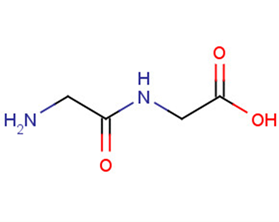
Glycyl-glycine
CAS No. 556-50-3
Glycyl-glycine( Diglycine | Diglycocoll | Glycine dipeptide | N-Glycylglycine | Gly-gly )
Catalog No. M20028 CAS No. 556-50-3
Glycylglycine (Gly-Gly) is a dipeptide used in biochemical research. It is the simplest of all dipeptides and is used as a starting template for preparation of more complex peptides. Glycine is involved in the body's production of DNA phospholipids and collagen and in the release of energy.
Purity : >98% (HPLC)
 COA
COA
 Datasheet
Datasheet
 HNMR
HNMR
 HPLC
HPLC
 MSDS
MSDS
 Handing Instructions
Handing Instructions
| Size | Price / USD | Stock | Quantity |
| 500MG | 38 | In Stock |


|
| 1G | Get Quote | In Stock |


|
Biological Information
-
Product NameGlycyl-glycine
-
NoteResearch use only, not for human use.
-
Brief DescriptionGlycylglycine (Gly-Gly) is a dipeptide used in biochemical research. It is the simplest of all dipeptides and is used as a starting template for preparation of more complex peptides. Glycine is involved in the body's production of DNA phospholipids and collagen and in the release of energy.
-
DescriptionGlycylglycine (Gly-Gly) is a dipeptide used in biochemical research. It is the simplest of all dipeptides and is used as a starting template for preparation of more complex peptides. Glycine is involved in the body's production of DNA phospholipids and collagen and in the release of energy.
-
In Vitro——
-
In Vivo——
-
SynonymsDiglycine | Diglycocoll | Glycine dipeptide | N-Glycylglycine | Gly-gly
-
PathwayOthers
-
TargetOther Targets
-
RecptorOthers
-
Research Area——
-
Indication——
Chemical Information
-
CAS Number556-50-3
-
Formula Weight132.12
-
Molecular FormulaC4H8N2O3
-
Purity>98% (HPLC)
-
SolubilityIn Vitro:?H2O : 130 mg/mL (983.95 mM)
-
SMILESNCC(=O)NCC(O)=O
-
Chemical Name——
Shipping & Storage Information
-
Storage(-20℃)
-
ShippingWith Ice Pack
-
Stability≥ 2 years
Reference
1.Van Hove JL et al. Benzoate treatment and the glycine index in nonketotic hyperglycinaemia. J Inherit Metab Dis. 2005;28(5):651-63.
molnova catalog



related products
-
2alpha-hydroxy-3beta...
Reference standards.
-
Hannokinol
(+)-Hannokinol and MESO-hannokinol can significantly inhibit lipopolysaccharide-induced nitric oxide production in BV2 microglial cells at concentrations ranging from 1 microM to 100 microM.
-
Amaranth
Amaranth as a potential component of lifestyle modification to improve cardiovascular risk profiles by modifying cardiovascular risk factors such as cholesterol diabetes and hypertension.



 Cart
Cart
 sales@molnova.com
sales@molnova.com


